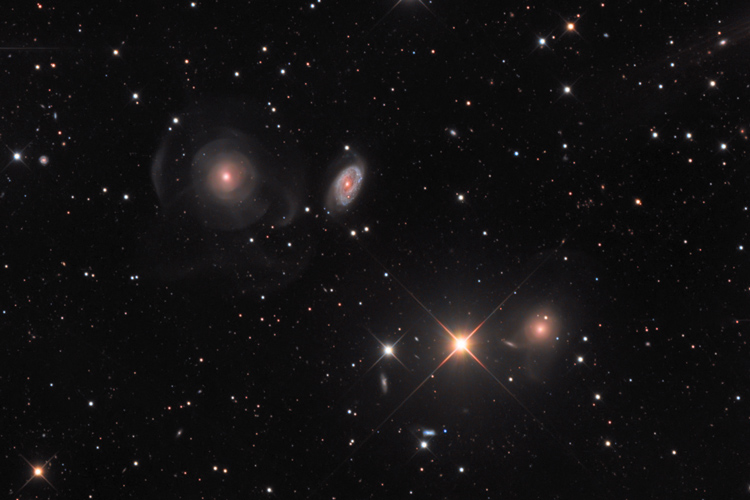|
Home
Recent Images
Galaxies
Nebulae
Natural Color
Narrow Band
H-Alpha
Clusters
Comets
Solar System
Observatory
Equipment
My Freeware
Tips & Tricks
Published Images
Local Weather
Terrestrial
Send Email
|
NGC 467, 470 & 474

Click the image for a 0.85 arcsec/pixel
display (2364 x 1577) 1.04 MB.
|
Instrument |
12.5" RCOS @
~f/9 (2880 mm fl). Imaged at 0.64 arcsec/pixel, shown at
0.85 and 2.69. |
|
Mount |
Paramount ME |
|
Camera |
SBIG STL-11000 w/
FW8 filter wheel, AstroDon Filters |
|
Acquisition Data |
11/13/2012 to 1/8/2013
Chino Valley, AZ. with CCDSoft and CCDAutoPilot |
|
Exposure |
Lum
660 min. (22 x 30 min. bin 1x1)
RGB
450 min. (10 x 15 min. bin 2x2) each |
|
Software |
-
CCDSoft, CCDStack, PixInsight
and Photoshop CS6.
-
eXcalibrator v4.25
for (g:r) color balancing, using 37 stars from the SDSS-DR9
database.
-
CCDBand-Aid to repair
Kodak KAI-11000M vertical bars.
-
CCDStack to
calibrate, register, data reject, combine the sub
exposures and create the RGB
image.
-
PixInsight for
gradient removal, initial non-linear stretching, noise reduction
and selective HDRMultiscaleTransform.
-
PhotoShop to
create the LRGB
final touch-up.
-
Noiseware 5 for
background touch-up.
|
|
Comment |
North is to the top.
This colorful cosmic skyscape features a peculiar system of galaxies
cataloged as Arp 227 some 100 million light-years distant. Swimming
within the boundaries of the constellation Pisces, Arp 227 consists
of the two galaxies prominent on the left; the curious shell galaxy
NGC 474 and its blue, spiral-armed neighbor NGC 470. The faint, wide
arcs or shells of NGC 474 could have been formed by a gravitational
encounter with neighbor NGC 470. Alternately the shells could be
caused by a merger with a smaller galaxy producing an effect
analogous to ripples across the surface of a pond. Remarkably, the
large galaxy on the right hand side of the image, NGC 467,
appears to be surrounded by faint shells too, evidence of another
interacting galaxy system. Background galaxies are scattered around
the field that also includes spiky foreground stars. Of course,
those stars lie well within our own Milky Way Galaxy.
Source: NASA
APOD
|
|